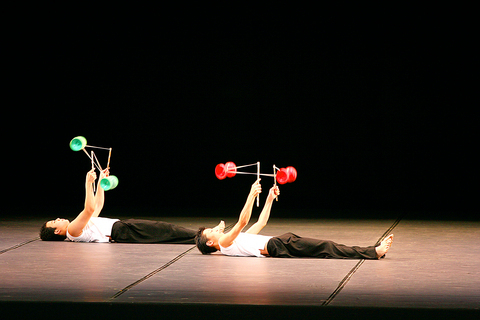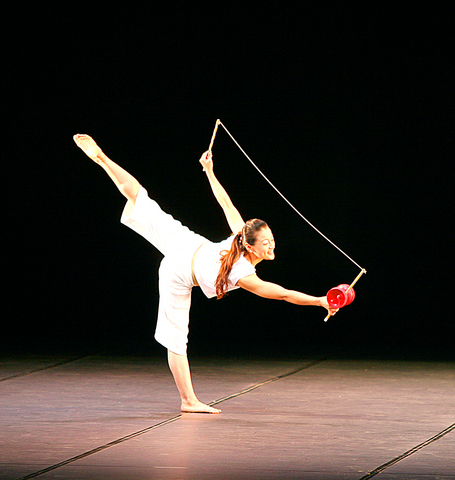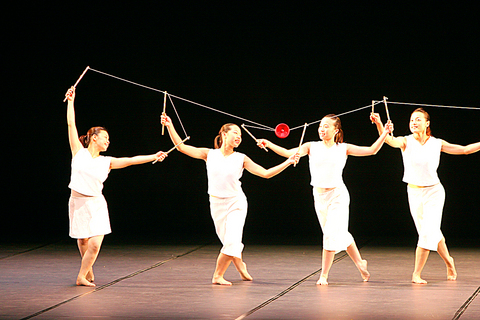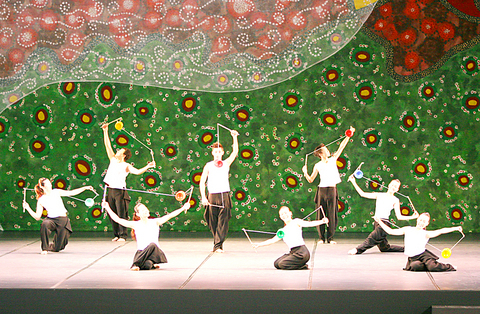Diabolo Dance Theater (
Diabolo, which comes from the Greek dia (across) and bale (throw) doesn't give you much idea of the actual object or its history. The diabolo is a toy that was invented 4,000 years ago in China where it was called "hollow bamboo" (
English and French travelers to China took the toy back home to Europe with them around 1800, where it was given the name of diabolo. The game gained popularity in the 19th century among aristocrats, who played it like tennis with elegant poses and in dainty white outfits. The object itself underwent a few changes and the hourglass shape emerged (a form that would later gain popularity in China and Taiwan).

Chinese Nationalist Party (KMT) members brought diabolos -- the old bamboo kind -- to Taiwan in the late 1940s. The game found its way into public schools as part of the physical education for elementary students.
"In Taiwan, many people can do it but only a little bit," said Diabolo Dance Theater's artistic director Liu Le-chun (
Liu's idea for a diabolo dance group was born out of a passion for fun. Years ago as an elementary school teacher, Liu's favorite part of the day was the afternoon PE class when he would teach his students to play with the diabolo. The kids got quite good at it, but Liu noticed their movements were quick and tense. He wondered if there was a way to turn playing with the diabolo into a more graceful form of movement, like dance. Pretty soon a club had formed with musicians, dancers and many enthusiastic students.

"At first it was just for fun and we didn't know what it would become ? The most unexpected thing was that the kids themselves wanted to keep up with diabolo."
In 1993, Diabolo Dance Theater was officially founded and Liu left his teaching post to lead the group full time. Until recently, Diabolo has remained relatively low profile in the world of performing arts.
The performers are almost all high school students -- only a handful are salaried performers. While a majority of Taiwan's more prominent dance or acrobatics troupe members have received full-time education in these disciplines, Diabolo's dancers study accounting or other such non-artistic subjects.

"We've surprised many a performing arts professional. They ask, `Who are these people and how did they suddenly appear on the scene?'" Liu said.
Despite little recognition, Diabolo Dance Theater has consistently produced high-caliber performances that bring creativity to the ancient game of diabolo.
According to Liu, the tradition of diabolo performance is strict and formal, with rules about costume, music, makeup and movement that are in line with the tradition of Chinese opera and acrobatics.

Diabolo Dance Theater is a departure from tradition in that it uses a wide variety of costumes, music, movement, lighting and props. For example, their performances have incorporated dramatic lighting aspects such as lasers, black light and huge shadows; costumes that range from fantastical clown outfits to roller skates; and music that is a bit more familiar and fun for a modern audience.
The hard work and creativity has paid off. In 2002, Diabolo Dance Theater was invited to perform at New York's Lincoln Center and last month it went to Aichi World Expo with a delegation of five Taiwanese groups that included Lin Hwai-min's (
The performance will differ most obviously from Diabolo's past performances in the use of classical music -- Wolfgang Amadeus Mozart and Franz Schubert, among others.
"We had never used [classical music] before because its elements are so fine and subtle, unlike more modern music where the rhythm is easier to hear," Liu said.
The idea is that subtler music will help to accent the diabolo dancers' movements, which will be slower and more elegant than in past performances, Liu said. "We thought about why, in its simplest form, is the diabolo appealing, and we started from there."
The performance consists of six "games," each with a different season as its theme, starting with summer and ending with spring. As the seasons progress, the games transform from being carefree childish sports to teenage romance.
According to Liu, this progression represents the length of time that many members stay with the group -- from elementary school, through high school and even college.
"This kind of performance is quite rare. Even in the circus, nobody spends 70 minutes on just the diabolo. So our challenge is how to use such a simple thing as the diabolo to entertain an audience for 70 minutes," Liu said.
Clearly, they have succeeded. As of press time there were less than 100 tickets remaining unsold for each performance.
Performance notes:
What: The Game of Diabolo Dance
Where: National Theater 21-1 Zhongshan S Rd, Taipei
When: Tonight and tomorrow at 7:30pm, Sunday at 2:30pm
Tickets: NT$350 to NT$1,200, available through Artsticket outlets, (02) 3393 9888 or www.artsticket.com.tw

The low voter turnout for the referendum on Aug. 23 shows that many Taiwanese are apathetic about nuclear energy, but there are long-term energy stakes involved that the public needs to grasp Taiwan faces an energy trilemma: soaring AI-driven demand, pressure to cut carbon and reliance on fragile fuel imports. But the nuclear referendum on Aug. 23 showed how little this registered with voters, many of whom neither see the long game nor grasp the stakes. Volunteer referendum worker Vivian Chen (陳薇安) put it bluntly: “I’ve seen many people asking what they’re voting for when they arrive to vote. They cast their vote without even doing any research.” Imagine Taiwanese voters invited to a poker table. The bet looked simple — yes or no — yet most never showed. More than two-thirds of those

In the run-up to the referendum on re-opening Pingtung County’s Ma-anshan Nuclear Power Plant last month, the media inundated us with explainers. A favorite factoid of the international media, endlessly recycled, was that Taiwan has no energy reserves for a blockade, thus necessitating re-opening the nuclear plants. As presented by the Chinese-language CommonWealth Magazine, it runs: “According to the US Department of Commerce International Trade Administration, 97.73 percent of Taiwan’s energy is imported, and estimates are that Taiwan has only 11 days of reserves available in the event of a blockade.” This factoid is not an outright lie — that

Former Chinese Nationalist Party (KMT) chairwoman Hung Hsiu-chu’s (洪秀柱) attendance at the Chinese Communist Party’s (CPP) “Chinese People’s War of Resistance Against Japanese Aggression and the World Anti-Fascist War” parade in Beijing is infuriating, embarrassing and insulting to nearly everyone in Taiwan, and Taiwan’s friends and allies. She is also ripping off bandages and pouring salt into old wounds. In the process she managed to tie both the KMT and the Democratic Progressive Party (DPP) into uncomfortable knots. The KMT continues to honor their heroic fighters, who defended China against the invading Japanese Empire, which inflicted unimaginable horrors on the

Sitting on a bus bound for Heping Island (和平島), at the start of my first visit to Keelung in years, I was hell-bent on visiting a place of considerable historical interest, even though I knew that it wasn’t officially open to the public. In 2011, archaeologists working in the densely populated southern half of the island unearthed the foundations of the Convento de Todos los Santos (Convent of All Saints, 諸聖教堂), a Catholic house of worship established during Spain’s 1624-1642 occupation of northern Taiwan. I’d heard about its rediscovery a while ago, but it wasn’t until I read a scholarly